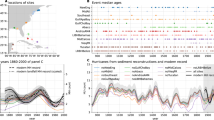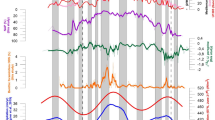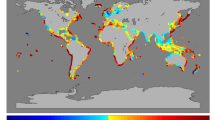Abstract
Hurricane activity in the North Atlantic Ocean has increased significantly since 1995 (refs 1, 2). This trend has been attributed to both anthropogenically induced climate change3 and natural variability1, but the primary cause remains uncertain. Changes in the frequency and intensity of hurricanes in the past can provide insights into the factors that influence hurricane activity, but reliable observations of hurricane activity in the North Atlantic only cover the past few decades2. Here we construct a record of the frequency of major Atlantic hurricanes over the past 270 years using proxy records of vertical wind shear and sea surface temperature (the main controls on the formation of major hurricanes in this region1,3,4,5) from corals and a marine sediment core. The record indicates that the average frequency of major hurricanes decreased gradually from the 1760s until the early 1990s, reaching anomalously low values during the 1970s and 1980s. Furthermore, the phase of enhanced hurricane activity since 1995 is not unusual compared to other periods of high hurricane activity in the record and thus appears to represent a recovery to normal hurricane activity, rather than a direct response to increasing sea surface temperature. Comparison of the record with a reconstruction of vertical wind shear indicates that variability in this parameter primarily controlled the frequency of major hurricanes in the Atlantic over the past 270 years, suggesting that changes in the magnitude of vertical wind shear will have a significant influence on future hurricane activity.
This is a preview of subscription content, access via your institution
Access options
Subscribe to this journal
Receive 51 print issues and online access
$199.00 per year
only $3.90 per issue
Buy this article
- Purchase on Springer Link
- Instant access to full article PDF
Prices may be subject to local taxes which are calculated during checkout




Similar content being viewed by others
References
Goldenberg, S. B., Landsea, C. W., Mestas-Nuñez, A. M. & Gray, W. M. The recent increase in Atlantic hurricane activity: causes and implications. Science 293, 474–479 (2001)
Jarvinen, B. R., Neumann, C. J. & Davis, M. A. S. A tropical cyclone data tape for the North Atlantic basin, 1886–1983: Contents, limitations, and uses. NOAA Tech. Memo. NWS NHC Vol. 22 1–21 (NOAA, Coral Gables, Florida, 1984)
Mann, M. E. & Emanuel, K. A. Atlantic hurricane trends linked to climate change. Eos 87, 233–241 (2006)
Shapiro, L. J. & Goldenberg, S. B. Atlantic sea surface temperature and tropical cyclone formation. J. Clim. 11, 578–590 (1998)
Goldenberg, S. B. & Shapiro, L. J. Physical mechanisms for the association of El Niño and West African rainfall with Atlantic major hurricane activity. J. Clim. 9, 1169–1187 (1996)
Enfield, D. B., Mestas-Nuñez, A. M. & Trimble, P. J. The Atlantic multidecadal oscillation and its relation to rainfall and river flows in the continental U.S. Geophys. Res. Lett. 28, 2077–2080 (2001)
Emanuel, K. Increasing destructiveness of tropical cyclones over the past 30 years. Nature 436, 686–688 (2005)
Curry, J. A., Webster, P. J. & Holland, G. J. Mixing politics and science in testing the hypothesis that greenhouse warming is causing a global increase in hurricane intensity. Bull. Am. Meteorol. Soc. 87, 1025–1038 (2006)
Elsner, J. B., Kara, A. B. & Owens, M. A. Fluctuations in North Atlantic hurricane frequency. J. Clim. 12, 427–437 (1999)
Neumann, C. J., Jarvinen, B. R., McAdie, C. J. & Elms, J. D. Tropical Cyclones of the North Atlantic Ocean, 1871–1998 11–15 (National Climatic Data Center, Asheville, North Carolina, 1999)
Landsea, C. W. et al. in Hurricanes and Typhoons: Past, Present and Future (Murname, R. J. & Liu, K.-B.) 177–221 (Columbia Univ. Press, New York, 2004)
Avila, L. A., Pasch, R. J. & Jiing, J.-G. Atlantic tropical systems of 1996 and 1997: years of contrasts. Mon. Weath. Rev. 128, 3695–3706 (2000)
Aiyyer, A. R. & Thorncroft, T. Climatology of vertical wind shear in the tropical Atlantic. J. Clim. 19, 2969–2983 (2006)
DeMaria, M., Balk, J.-J. & Kaplan, J. Upper-level eddy angular momentum fluxes and tropical cyclone intensity change. J. Atmos. Sci. 50, 1133–1147 (1993)
Dong, B., Sutton, R. T. & Scaife, A. A. Multidecadal modulation of El Niño–Southern Oscillation (ENSO) variance by Atlantic Ocean sea surface temperatures. Geophys. Res. Lett. 33 L08705 doi: 10.1029/2006GL025766 (2006)
Nyberg, J. Luminescence intensity in coral skeletons from Mona Island in the Caribbean Sea and its link to precipitation and wind speed. Phil. Trans. R. Soc. Lond. A 360, 749–766 (2002)
Black, D. E. et al. Eight centuries of North Atlantic ocean atmosphere variability. Science 286, 1709–1713 (1999)
Knaff, J. A. Implications of summertime sea level pressure anomalies in the tropical Atlantic region. J. Clim. 10, 789–804 (1997)
Kalnay, E. et al. The NCEP/NCAR 40-year reanalysis. Bull. Am. Meteorol. Soc. 77, 437–471 (1996)
Mann, M. E., Bradley, R. S. & Hughes, M. K. Global-scale temperature patterns and climate forcing over the past six centuries. Nature 392, 779–787 (1998)
Vitart, F. & Anderson, J. L. Sensitivity of Atlantic tropical storm frequency to ENSO and interdecadal variability of SSTs in an ensemble of AGCM integrations. J. Clim. 14, 533–545 (2001)
Smith, T. M. & Reynolds, R. W. Improved extended reconstruction of SST (1854–1997). J. Clim. 17, 2466–2477 (2004)
Landsea, C. W., Nicholls, N., Gray, W. M. & Avila, L. A. Downward trends in the frequency of intense Atlantic hurricanes during the past five decades. Geophys. Res. Lett. 23, 1697–1700 (1996)
Elsner, J. B., Jagger, T. & Kocher, B. Changes in the rates of North Atlantic major hurricane activity during the 20th century. Geophys. Res. Lett. 27, 1743–1750 (2000)
Elsner, J. B. & Jagger, T. H. Prediction models for annual US hurricane counts. J. Clim. 19, 2935–2952 (2006)
Gray, S. T., Graumlich, L. J., Betancourt, J. L. & Pederson, G. T. A tree-ring based reconstruction of the Atlantic Multidecadal Oscillation since 1567 AD. Geophys. Res. Lett. 31 L12205 doi: 10.1029/2004GL019932 (2004)
Lean, J. 2000. Evolution of the Sun's spectral irradiance since the Maunder Minimum. Geophys. Res. Lett. 27, 2425–2428 (2000)
Shindell, D. T. et al. Solar forcing of regional climate during the Maunder Minimum. Science 294, 2149–2152 (2001)
Held, I. M. & Soden, B. J. Robust responses of the hydrological cycle to global warming. J. Clim. 19, 5686–5699 (2006)
Woodruff, S. D., Slutz, R. J., Jenne, R. L. & Steurer, P. M. A comprehensive ocean-atmosphere data set. Bull. Am. Meteorol. Soc. 68, 1239–1250 (1987)
Barnes, D. J., Taylor, R. B. & Lough, J. M. Measurement of luminescence in coral skeletons. J. Exp. Mar. Biol. Ecol. 295, 91–106 (2003)
Watanabe, T. A., Winter, A., Oba, T., Anzai, R. & Ishioroshi, H. Evaluation of the fidelity of isotope records as an environmental proxy in the coral Montastraea. Coral Reefs 21, 169–178 (2002)
Hendy, E. J., Gagan, M. K. & Lough, J. M. Chronological control of coral records using luminescent lines and evidence for non-stationary ENSO teleconnections in northeast Australia. Holocene 13, 187–199 (2003)
Acknowledgements
This work is supported by grants from the Swedish Research Council (to J.N.).
Author Contributions J.N. derived the coral records, the vertical wind shear and hurricane reconstructions and wrote the paper, except for the Figs 1 legend and parts of the penultimate paragraph, which were written by M.R.J. M.R.J., B.A.M., A.W. and K.H.K. assisted and commented on the manuscript. K.H.K. and T.M.Q. provided X-rayed slices from the coral core retrieved 2004 outside La Parguera.
Author information
Authors and Affiliations
Corresponding author
Ethics declarations
Competing interests
Reprints and permissions information is available at www.nature.com/reprints. The authors declare no competing financial interests.
Supplementary information
Supplementary Information
This file contains Supplementary Tables 1-4 with Legends; Supplementary Figures 1-3 with Legends and additional references. Supplementary Table 1 shows correlation coefficients between the proxies used and instrumentally observed vertical windshear and reliable observed number of major hurricanes. Supplementary Table 2 shows correlation coefficients between luminescence intensity in the different coral cores. Supplementary Tables 3 and 4 show type and performance of the ten independent neural networks and multiple regression results. Supplementary Figures 1 and 2 show results from wavelet spectral and spectral analyses. Supplementary Figure 3 shows Caribbean temperatures. (PDF 456 kb)
Rights and permissions
About this article
Cite this article
Nyberg, J., Malmgren, B., Winter, A. et al. Low Atlantic hurricane activity in the 1970s and 1980s compared to the past 270 years. Nature 447, 698–701 (2007). https://doi.org/10.1038/nature05895
Received:
Accepted:
Issue Date:
DOI: https://doi.org/10.1038/nature05895
This article is cited by
-
Natural and anthropogenic contributions to the hurricane drought of the 1970s–1980s
Nature Communications (2022)
-
Changes in Atlantic major hurricane frequency since the late-19th century
Nature Communications (2021)
-
Hurricane trend detection
Natural Hazards (2020)
-
Tropical cyclone rainfall variability in coastal North Carolina derived from longleaf pine (Pinus palustris Mill.): AD 1771–2014
Climatic Change (2016)
-
Atlantic hurricane activity during the last millennium
Scientific Reports (2015)
Comments
By submitting a comment you agree to abide by our Terms and Community Guidelines. If you find something abusive or that does not comply with our terms or guidelines please flag it as inappropriate.



